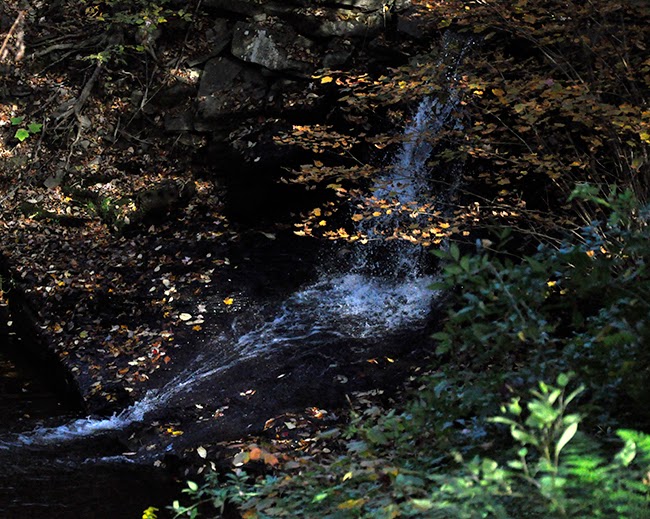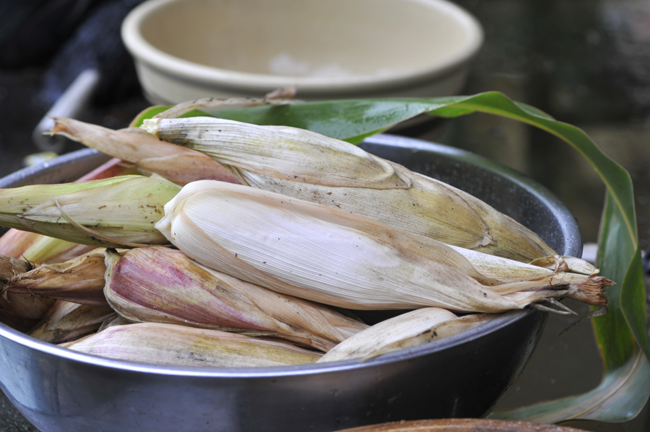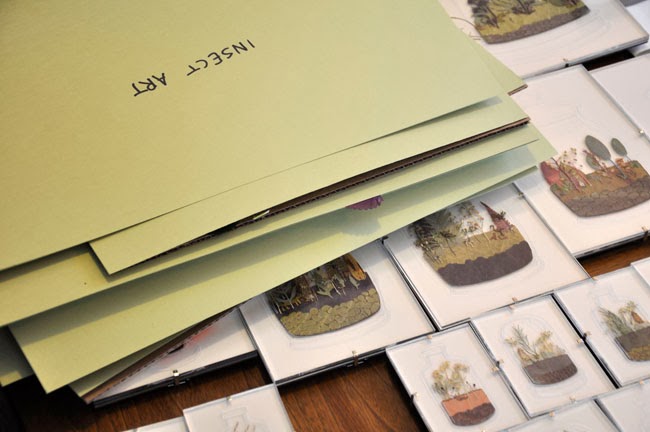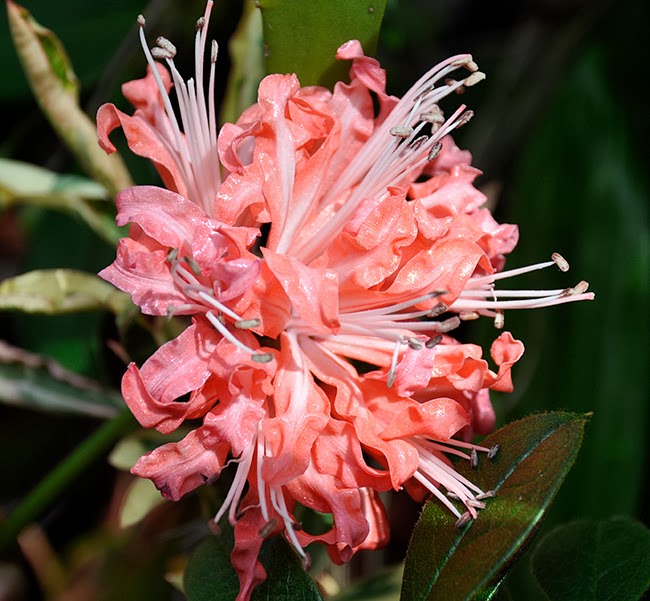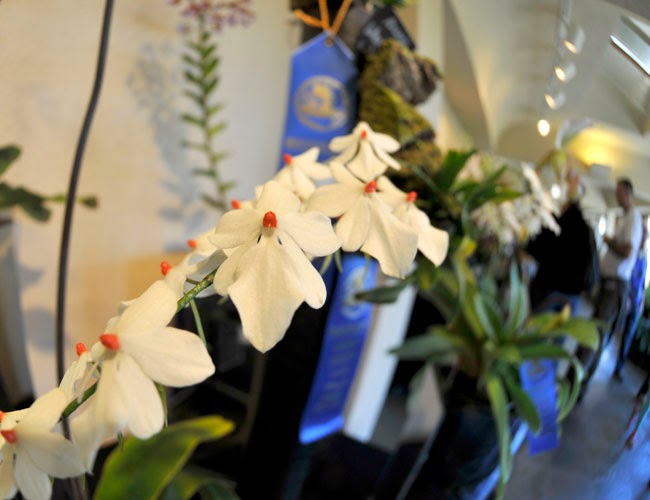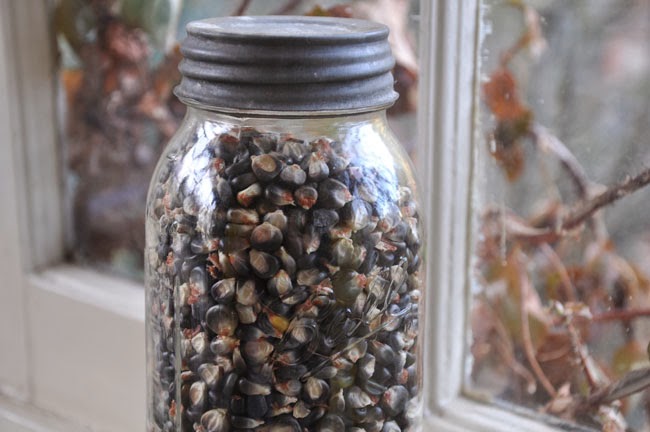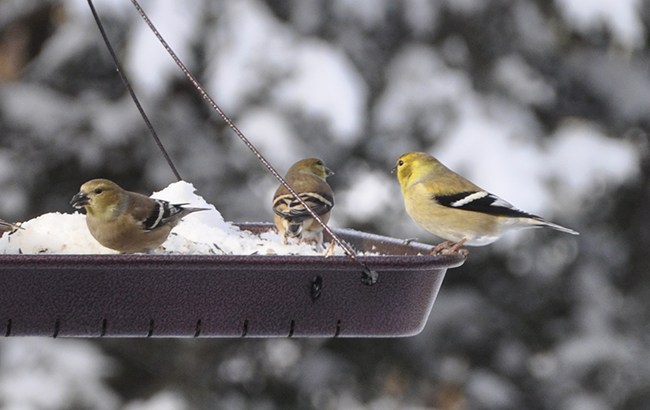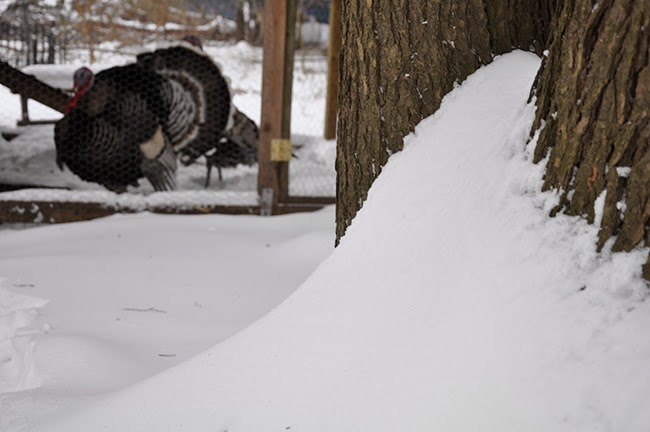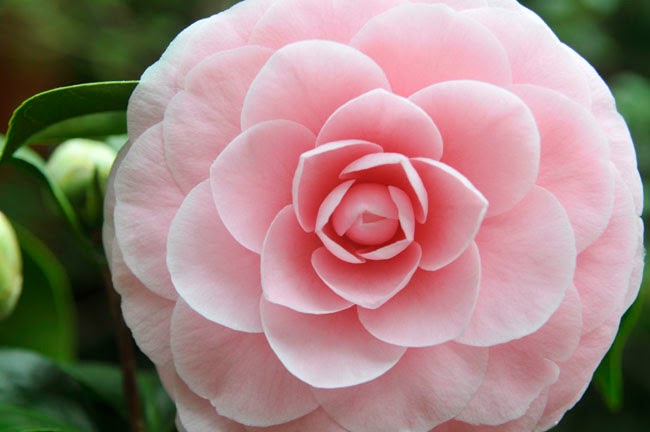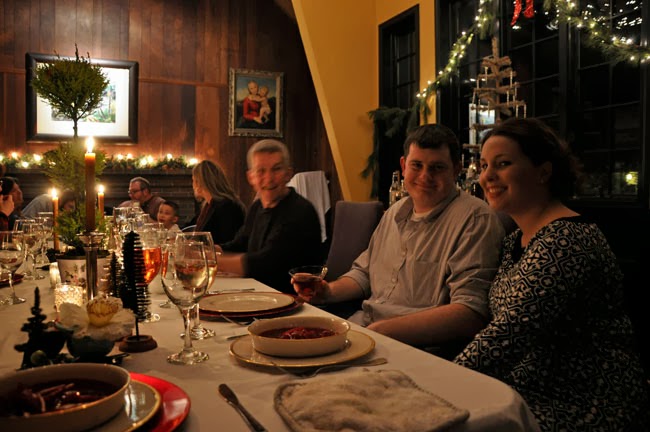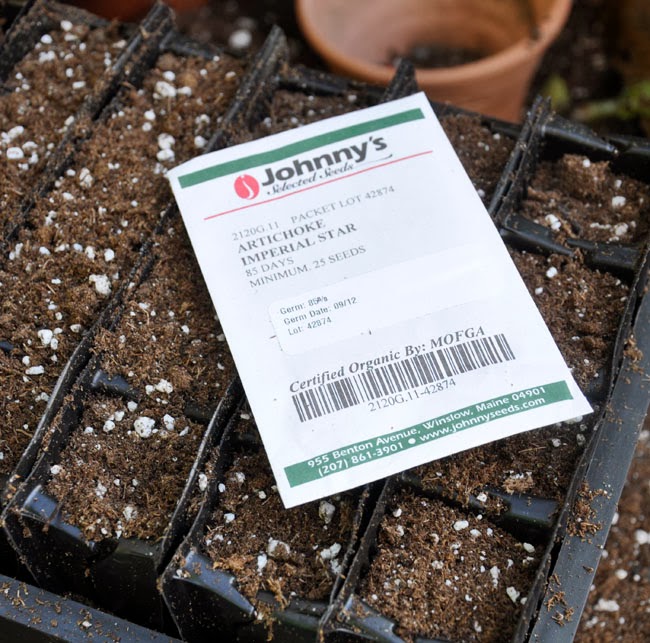It seems everywhere we look today, there are amaryllis. On those hip lifestyle blogs "white Amaryllis for Christmas", on Pinterest ( you know, "how to grow an amaryllis in a jar"), every single retail store has them merchandised in handy kits on endcaps, even your local hardware store carries these easy-to-grow and showy giants. "They're just McMansion housewife flowers" one of my younger, and most cynical graphic designers called them, this past weekend. Ugh. Probably because they can look as tasteless as a tacky Holiday sweater to some who cannot associate memories or nostalgia with them, but the amaryllis has much more to offer than mere holly berry red and snowman white seasonal metaphors worthy of a Restoration Hardware catalog cover.
The genus is broad and the newest hybrids, exotic spider flowered 'cybister' types, dwarf miniatures and curious rare species can be so incredibly interesting, that getting bored is hardly an option. For me, who comes from a time when there was only 5 forms available, todays wide selection can only mean that the amaryllis is becoming more and more interesting each and every year. After all, amaryllis really deliver on all fronts, except perhaps fragrance. It really all comes down to finding the best varieties, and growing them in the best manner. So I will share my amaryllis secrets ( and a few gripes) with you.
There was a time, in the mid 1960's for instance when I started growing these giant bulbs, when obtaining an amaryllis was a bit more challenging than it is today. One could only find them at specialty nurseries, or via mail order. Today, it's a different story, with bulbs showing up on the cover of most every bulb catalog, and
now found in virtually every market, Walmart or big box hardware store. Yes,
they are that easy to grow, as everyone may tell you, but they are not fool proof, and like anything when it
comes to plants, there are great facts one must know, but which are rarely told, as sage advice and step-by-step posts repeat cliche statements, and pass along poor information. In just this past week, I have read so many posts which had misinformation, that I feel that I must speak up and rumble a bit, about what works, and what doesn't when it comes to amaryllis.
This is a longer than normal post, so if you don’t want to
read on, but if you are in a hurry, here is my executive top-line.
1 1. Buy your bulbs from a reputable grower - I get mine from White
Flower Farm ( they have the largest bulbs and although they are expensive, I find them worth
the cost. I also buy some from my local market, don't worry.
2. Grow them like a big boy ( or big girl) – that means no vases
with stones, no jars, canning jars with coir, no bulb vases – there is a reason
why they stopped making them in 1608).
3. No matter what other blogs may tell you, throw your bulbs away when you are done. Yep. I don’t care if you
have seed pods, or if you germinated a seed once, no trying to re-bloom.
I am just being realistic. Read on,
and you’ll see why.
![]()
I grew my first amaryllis in the 1960’s when I was just a
wee kid, purchasing a large, fat bulb with the bud just emerging from a local hardware
store (Spags – as in “No Bags at Spags”). My mom allowing me to spend my
allowance on paperwhites, baseball
cards, amaryllis and Hot Wheels – not always in that order. You guessed it, I
was not your ‘normal’ kid. Unless you consider weaving potholders and saving
your own radish seeds as an expression of ‘normal’.
Getting bulbs to bloom for Christmas
Many of us now associate large, showy red and white
amaryllis with the Holiday season, but the truth is, this is a bit early for
most amaryllis bulbs being forced into bloom in the Northern hemisphere, as
most need 10-14 weeks to emerge and bloom, often in late January or
February. Christmas blooming
amaryllis is actually a newer trend, which is why you may be noticing some bulb
catalogs separating Christmas-blooming varieties from regular named varieties.
The bulbs sold as Christmas blooming, are generally ( or should be) those bulbs
that have been grown in the most southerly part of our earths Southern
Hemisphere ( Peru, Chile and South Africa), and indeed, these are the only
amaryllis that will bloom in time for Christmas.
This is important to know, if you really want amaryllis in
bloom for Christmas, as most every supermarket and hardware store is currently
carrying boxed or loose amaryllis, with the promise of flowers-by-Christmas,
but in most of these cases, you really cannot know if these are indeed these
specially treated and harvested bulbs.
Just purchasing your bulbs early, and planting them by
Thanksgiving will not guarantee that you will have flowers by the New Year. you
really need to be certain that you have purchased bulbs from a reliable source,
and one that ensures that they have been properly grown in the most southerly
party of the southern hemisphere as these are the bulbs that are most likely to
bloom for Christmas. Helpful information, as more than 80% of all commercial
amaryllis are grown in the Netherlands, or Israel. Bulbs that will bloom best
in mid-winter, and not Christmas. That said, these later blooming varieties
include the most beautiful
selections.
The Proper Way to grow Amaryllis
It’s true, one cannot go wrong with an amaryllis bulb, at
least if you just want it to bloom. It really doesn’t matter on the price or
size, or where it came from, as the flowerbuds have already been formed deep inside
the bulb, and it is essentially preprogrammed to grow, ( even the term
‘forcing’ isn’t really right in this case, but I’ll let it slide), and unless
they have been exposed to freezing temperatures, there is often no stopping an
eager amaryllis from blooming, ( you know, those sad, twisted white stems
emerging from the bulbs at Home Depot). They are dumb easy.
But, they can be grown to perfection, and here’s how:
First, I need
to address this current trend of growing bubs in decorative gravel, in vases, jars,
glass vessels. I know it looks cool, but it is poor horticulture, and it raises
your chances of failure immensely. The amaryllis bulb is
actually a fine-tuned machine. In the wild, or in the garden most plants in the
amaryllis family form thick, fleshy roots – roots that often never die back,
but rather do much of their work during the plants dormancy, which as it is
with most plants native to the Cape of South Africa, is roughly half of the year.
Amaryllis are designed to go ‘dormant’ once the winter rains
pass, and the bone dry summer arrives. Yet underground, the plant is hardly
dormant at all, as recent studies show that these fleshy roots do much of their
valuable work during this dry ‘rest’, when the plant is actually barely resting
at all. As anyone who attempts to bloom a Clivia will attest, plants within the
amaryllid family, have this propensity for being difficult to bloom, or
rebloom, and this all goes back to their native habitat – to when they form
their buds deep inside their bulb scales, and why their roots never really go
dormant.
Wait, their roots never go dormant? Why that ain’t true, you
may say, as the bulb you just bought has no roots……
Right. They were cut off, and just at the time they were
needed to extract the water and nutrients so necessary for bud formation in two
years. Yes, I said two years, because most amaryllids form their flower buds
three years in advance. So my rather long-winded point is that you pricey
amaryllis from White Flower Farm has two years worth of flower buds programmed
inside of it, but trying to get those immature flower bud nubbins for next year
to develop fully and properly will take some skill ( and luck) and as for those
buds necessary to form for Christmas 2015 – well they most have already been
compromised by shipping and handling, so we are really talking here about how one can get their amaryllis to
bloom in 2016….get my point?
Oh, and I should finish my original point about why not to vases or water with gravel in them... In those wet situations, the thick, succulent roots will simply rot, or at the very best, not function properly as amaryllis are very intolerant of wet feet, (they wont be able to absorb the proper nutrients from the gravel and water,
and they will be damaged, all for the sake of an Apartment Therapy worthy
photoshoot., Still, if you are just tossing your bulbs once they have bloomed,
go for it. But you will have to deal with slime, the smell and the potential
for rot.
The Importance of Amaryllis Bulb Size
Which brings us to bulb side, and number of stems. All
amaryllis will produce at least one fat bud, and you don’t need to buy one with
the bud emerging, in fact, most experts agree that this is not a good way to
choose a bulb, but between you and me, I do like to see a hint of a bud tip
showing J.
Amaryllis are sold commercially by size, and size equates
cost, in most cases. You get what you pay for with amaryllis. All amaryllis are
sold by centimeter ( look for 30
cm to 40cm bulbs if you want the promise of more than one stem from a bulb).
This is why I suggest White Flower Farm as your retail source ( there are other
sites that offer large bulbs, but then one must factor in variety, and WWF
offers an enormous selection of new varieties not found elsewhere). They are my
favorite sources for Amaryllis ( again, I have never been paid by them, nor
even talked to anyone there, I just like their sources, their buyers taste, and
the selection they offer – plus, I have had excellent success with them).
They buy the largest bulbs available, and most produce 3
stems, which can make a $35 bulb
much more justifiable. When buying a bulb, look for the .cm size, and suddenly,
those prices will begin to make sense. Sure you can buy an $8.99 bulb, as I did
last week that is 30+cm, but they are hard to find. ( thanks Wegmans!).
The Business of Amaryllis
Obviously, the business side of amaryllis is indeed big
business. The largest wholesale amaryllis growers are in the Netherlands, yet
some growers are in New Zealand, Israel and Peru. Just to give you an example
of the size of the agribusiness side of amaryllis -since 1999, the top ten Israeli growers supplies only 6%
of the global demand for amaryllis for the Christmas Season, and that is about
30 million bulbs, annually. ( from the Dutch floriculture industry report on
Amaryllis).
Propagating Amaryllis
Seeds may seem like an easy way to grow amaryllis, but
today, most are grown via micropropagation - tissue culture, as it is far more
practical than raising new plants from seed. If you have seed set on your
amaryllis, you can certainly try, but it is a futile venture. Amaryllis seed is
notoriously fussy and it has a low rate of germination, even for the experts. So
if you have seed, one or two may germinate, but considering the time it will
take for you to grow-on the seedlings, the complex nutrition required and the
light quality – basically, anyone who is telling you that you can grow your
amaryllis from seed is terribly amateurish.
The only time growers bother to propagate from seed is when
they are breeding for new varieties, or when they are looking for variation.
The rest? Tissue culture. This method of starting millions of plants in a
laboratory from cells ensures perfections, and supplies us with the multiple
clones of a specific selection – i.e. named varieties that you see in catalogs.
If I wanted to multiply a bulb, I would cut the bulb, split
like an onion, and try to attempt basal plate propagation as I do when I bulb
chip nerine, but really – it’s just not worth it, as rot, the time required for
proper growth to blooming size. I rather buy my bulbs.
How to get your Amaryllis to rebloom
If you insist on trying to rebloom your bulbs next year ( I
have done it, but it does have its downside), here is my best advice:
Remember -Your bulb is a plant, and in order to achieve any
success, you will need to plan on not just growing your bulb, but on
cultivating it. Plants are living things, which require proper care based on
sound, horticultural science. So
plan on finding the proper nutrients ( low nitrogen, high phos.and pot), the
proper micro nutrients, the right amount of sunlight and day length, and the
best soil medium you can provide. Amaryllis prefer a porous, faster draining soil, with some organic matter, but perhaps
with more perlite or gravel than one may think that they need.
Amaryllis require a soil pH of 6.5,
which makes the idea of growing them in pure peat or coir as they commercial
distributors often supply with your bulb, absurd. Find a good, balanced
professional potting mix, and add 30% gravel or perlite to lighten the mix,
along with dolomitic limestone. One potted, your amaryllis should not need
repotting for 3 years in this soil, which it will appreciate, for as I
mentioned earlier, amaryllis dislike anyone touching their roots, let alone
cutting them off!
Starting your own Amaryllis from seed
I need to be honest – raising your own amaryllis from seed
is a silly idea, best left to the inexperienced amateur gardeners who somehow,
love to post about their unbelievable ease in both pollinating and raising
their own amaryllis ( right). It
is likely that your amaryllis will set seed, yet unless you pollinated
properly, the odds are your seed will be mostly sterile. Even well pollinated
plants commercially is challenging, seeds may germinate, especially if sown fresh, which one must do with any amaryllis, but long term success
is highly unrealistic. It's just too difficult to provide all of the needs a young amaryllis will ask for. I wouldn’t lie to you about these sort of things.
If you live in the southern US, you might be saying “why, Matt, we have lots of amaryllis growing in
our gardens, and some even form large clumps,. They aren’t that tough to grow.”
True, but those old types ( often referred to as “Mead
types” the ones you are most likely talking about) are forms developed by a
Dr. Mead decades ago in Florida. These old varieties are more likely to come
‘true from seed’ , but they are nothing like the large Dutch varieties which
most people want in their homes during the Holidays. Oh, and if you have seeds
of these, please share. J
If you live in the south, or in an area where amaryllis can
be grown outdoors, then that is another story. You may want to try growing some from seed, if you have a
garden outdoors where you can coddle on the babies for the first few years. You
will have a better chance of growing plants from seed in the south, and you may
even get some interesting crosses, but again, the time and effort involved is
simply not worth the results. I don’t want to discourage you, but I do want to
be realistic, as I read two blog posts today about how easy it is to grow
amaryllis from seed ( one in Chicago, the other in Brooklyn). Go for it.
Diseases
There is one more reason why I don’t recommend saving your
bulbs, and this is a serious one. Amaryllis are highly prone to Virus’ and fungus will get them if your
aggressive watering talents don’t.
Most, if not all commercial amaryllis bulbs carry a mosaic
virus and a nasty fungus called ‘Red Blotch” (Stagonospora curtissi). There is
almost no avoiding it, eventually. You may even have seen this disease already,
but thought that it was some weird scratchy scar on a stem – it’s rather
harmless if you are disposing of the plant, but it will most certainly
interfere with any dormant flower buds for next year, as the fungus is spread
throughout the bulb scales and foliage. It is for this single reason, that I
dispose of most of my bulbs every year after they bloom.
These diseases can cause stems to curl, split or sometime
even to fold over under their own weight and break. Those red scabs are so common
on amaryllis, that growers call it damn ‘Red blotch” . It is the bain of all
commercial houses who breed and grow amaryllis, and staff must wear protective
clothing, booties, hose-downs and all bulbs are dipped in fungicide annually.
The fungus, called Stagonospora
curtisii is omnipresent in the clan – harmless to us, but sadly, it’s the AIDS
in the world of amaryllis.
If you are serious about growing-on your amaryllis, here is
the ugly part – you will need to drench your bulbs in fungicide too. A one half hour soak is required, as the
chemical must be absorbed systemically. And not any fungicide will do, you must
use a fungicide called Benlate™ (
not Captan as it does not work as well).Don’t assume that your bulbs are clean,
for most bulbs already have been exposed to Stagonospora.
I know, not
easy for most people to do, but the science doesn’t lie when it comes to
floriculture. Anyone who tells you to not worry about fungus and virus’ when it
comes to amaryllis growing clearly has not grown amaryllis for profit.
Sizes of amaryllis from major retailers:
Just a few retail sites and their bulb sizes.
Wooden Shoe Bulb Farm 30-32 cm
Holland Bulb farms (limited selection) 30-32 cm $20.97
Amaryllis Bulb Company 30-32 cm $18.00
White Flower Farm 40 cm + $35 -$45








